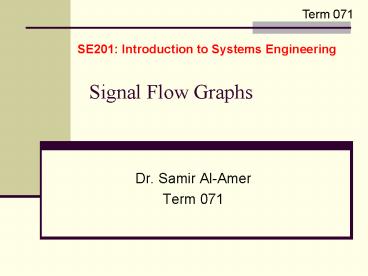Signal Flow Graphs PowerPoint PPT Presentation
1 / 24
Title: Signal Flow Graphs
1
Signal Flow Graphs
Term 071
SE201 Introduction to Systems Engineering
- Dr. Samir Al-Amer
- Term 071
2
Outlines
- Basic Elements of Signal Flow Graph
- Basic Properties
- Definitions of Signal Flow Graph Terms
- Mason Theory
- Examples
3
Basic Elements of Signal Flow Graph
- A Signal flow graph is a diagram consisting of
nodes that are connected by several directed
branches.
branch
branch
node
node
4
Basic Elements of Signal Flow Graph
- A node is used to represent a variable (inputs,
outputs, other signals) - A branch shows the dependence of one variable (
node) on another variable (node) - Each branch has GAIN and DIRECTION
- A signal can transmit through a branch only in
the direction of the arrow - If gain is not specified gain 1
G
B G A
A
B
5
Nodes
- A node is used to represent a variable
- Source node (input node)
- All braches connected to the node are leaving the
node - Input signal is not affected by other signals
- Sink node (output node)
- All braches connected to the node are entering
the node - output signal is not affecting other signals
D
Source node
A
B
C
Sink node
Z
V
X
Y
U
6
Relationship Between Variables
D
Source node
A
B
C
Sink node
Z
V
X
Y
U
Gain is not shown means gain1
U (input) XAUY YBX Z
CYDX VZ (output)
7
Another Example
D
Source node
B
A
Y
C
Sink node
Z
V
X
U
K
3
H
W
XAUY YBXKZ ZCYDXHW W3U VZ
8
Basic Properties
- Signal flow graphs applies to linear systems
only - Nodes are used to represent variables
- A branch from node X to node Y means that Y
depends on X - Value of the variable (node) is the sum of
gain of branch value of node - Non-input node cannot be converted to an input
node - We can create an output node by connecting unit
branch to any node
9
Terminology Paths
- A path is a branch or a continuous sequence of
branches that can be traversed from one node to
another node
B
A
Y
C
U
V
Z
X
K
3
H
W
Z
B
U
X
Z
A
Y
C
U
3
H
W
Paths from U to Z
10
Terminology Paths
- A path is a branch or a continuous sequence of
branches that can be traversed from one node to
another node - Forward path path from a source to a sink
- Path gain product of gains of the braches that
make the path
B
A
Y
C
Z
V
X
U
K
3
H
W
11
Terminology loop
- A loop is a closed path that originates and
terminates on the same node, and along the path
no node is met twice. - Nontouching loops two loops are said to be
nontouching if they do not have a common node.
B
A
Y
C
Z
V
X
U
K
3
H
W
12
An example
- a11 x1 a12 x2 r1 x1
- a21 x1 a22 x2 r2 x2
13
An example
- (1- a11 )x1 (- a12 ) x2 r1
- ( - a21 ) x1 (1- a22 )x2 r2
- This have the solution
- x1 (1- a22 )/D r1 a12 /D r2
- x2 (1- a11 )/D r2 a21 /D r1
- D 1 - a11 - a22 a22 a11 - a12 a21
14
An example
- D 1 - a11 - a22 a22 a11 - a12 a21
- Self loops a11 , a22 , a12 a21
- Product of nontouching loops a22 a11
15
SGF in general
- The linear dependence (Tij) between the
independent variable xi (input) and the dependent
variable (output) xj is given by Masons SF gain
formula
16
The determinant D
- Or
- D1 (sum of all different loop gains) (sum of
the gain products of all combinations of 2
nontouching loops) - -(sum of the gain products of all combinations of
3 nontouching loops) - The cofactor is the determinant with loops
touching the kth path removed
17
Example
- Determine the transfer function between V and U
B
A
Y
C
Z
V
X
U
K
3
H
W
- The number of forward paths from U to V ?
- Path Gains ?
- Loops ?
- Determinant ?
- Cofactors ?
- Transfer function ?
18
Example
- Determine the transfer function between V and U
B
A
Y
C
Z
V
X
U
K
3
H
W
- The number of forward paths from U to V 2
- Path Gains ABC, 3H
- Loop Gains B, CK
- Transfer function (ABC3H-3HB)/(1-B-CK)
19
An example
20
An example
- Two paths P1, P2
- Four loops
- P1 G1G2G3G4, P2 G5G6G7G8
- L1G2H2 L2G3H3 L3G6H6 L4G7H7
- D 1 - (L1L2L3L4)(L1L3L1L4L2L3L2L4)
- Cofactor for path 1 D1 1- (L3L4)
- Cofactor for path 2 D2 1-(L1L2)
- T(s) (P1D1 P2D2)/D
21
Another example
22
- 3 Paths
- 8 loops
23
Summary
24
Keywords
- Node
- Branch
- Path
- Loop
- Non-touching loops
- Loop gain
- Sink node
- Source node
- Forward path
- cofactor

